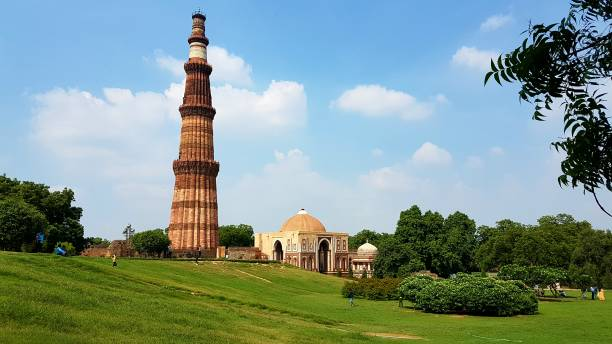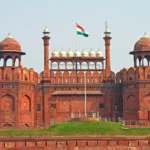It was a soft October evening in Delhi when I first saw Qutub Minar. Bathed in golden light, its towering silhouette seemed to pulse with centuries of memory—and I felt a magnetic pull. That moment sparked a story unfolding across history, artistry, and my very own breathless awe.
A Living Legacy in Stone
Foundations & Symbolism
The Qutub Minar began rising in 1199 under Qutb ud-Din Aibak, intended as both a victory tower and a call to faith—establishing the fledgling Delhi Sultanate after Prithviraj Chauhan’s fall WikipediaBritannica Kids. Though Aibak completed just the first level, his successor Iltutmish added three more up to the early 1220s WikipediaBritannica Kids.
Resilience & Reinvention
Lightning and earthquakes damaged it—yet, Firuz Shah Tughlaq rebuilt the top story and added a distinctive cupola in 1368 WikipediaUNESCO World Heritage CentreBritannica Kids. Sikandar Lodi’s restoration, Mughal touch-ups, and British-era modifications (like Smith’s Folly) layered more history onto the tower—Smith’s cupola was eventually removed, though left at ground level as a quirky reminder WikipediaUNESCO World Heritage Centre.
Monumental Measurements
At approximately 72.5 m tall (~238 ft), Qutub Minar claims the title of the tallest brick minaret globally WikipediaThe Wandering CoreBritannica Kids. Its base diameter (14.3 m) tapers impressively to 2.7 m at the top Wikipediastaybloom.com. Inside, 379 steep steps spiral upward—but entry to the top remains closed to visitors today, a precaution after a tragic stampede in the 1980s WikipediaThe Wandering Core.
Wandering Through the Qutub Complex
Walking into the Qutb Complex is like stepping through layers of time. The soaring arches of Quwwat-ul-Islam Mosque, built from repurposed Hindu and Jain temple stones, stand next to the towering minaret. It’s a potent symbol of both conquest and architectural dialogue WikipediaUNESCO World Heritage Centre.
Nearby, the Iron Pillar glimmers with its mysterious rust-resistant alloy—a metallurgical marvel from the 4th century, carved with ancient Sanskrit script UNESCO World Heritage CentreWikipedia. And there’s the unfinished Alai Minar, Sultan Alauddin Khalji’s grand vision stopped in its tracks—its skeletal frame reminding us how even empire ambitions can falter UNESCO World Heritage CentreEúnoia.
A Traveler’s Tale at Dusk
Let me share the scene that stays with me:
I reached the complex around sunset. A calm hush had settled over the stray stones. As the LED lights flickered on, Qutub Minar slipped into an ethereal mode—shedding its schoolbook greyscale and putting on a glow almost cinematic in its quiet power Eúnoia. I recall thinking: history is alive. You don’t just read it—you feel it, hanging in the air around you.
That evening, I finally understood why locals, even some Delhiites lifelong in the city, hesitated to visit. It’s not just a monument—it’s an emotion waiting to accept you.
A Comparative Glance with the Minaret of Jam
Seeing Qutub Minar beside its twin from Afghanistan, the Minaret of Jam, reveals a deeper regional narrative:
| Feature | Qutub Minar (Delhi) | Minaret of Jam (Afghanistan) |
|---|---|---|
| Height | ~72.5 m (tallest brick minaret) | ~62 m tall; all-brick construction Wikipedia+1EduauraaHikerWolf |
| Decorative Style | Fluted bands, muqarnas, inscriptions | Dense geometric and Quranic bands Wikipedia+1HikerWolf |
| Historical Role | Marker of conquest & religious power | Ghurid dynasty’s remote triumph |
| Condition | Well-maintained, accessible | More weathered, remote, poetic |
Qutub’s strength lies in cultural layering—its stones carry fragments of temple, mosque, and empire. Jam’s solitary height speaks instead of lost grandeur on a far plain.
Why Qutub Minar Still Matters Today
- Living Heritage: It pulses with stories—empire-building, devotion, ruin, and reinvention.
- Architectural Dialogue: Indigenous craftsmanship in temple spolia frames an Islamic monument filled with Persian-Arabic text, showing cultural conversation.
- Visual Storytelling: Tourists and locals alike share moments beneath its balconies, in its courtyards, on sunlit mornings or luminous evenings.
- Unexpected Emotion: Even frequent Delhi visitors confess they’ve never gone—and describe profound awe when they finally do EúnoiaInstagram.
Conclusion: More Than Stone, a Story
The Qutub Minar isn’t just a tourist landmark—it is a living, breathing testament to Delhi’s layered soul. From its ambitious beginnings under a slave-turned-sultan to its resilience through centuries, it invites us to stand beneath, look up, and feel history in every carved motif and shaded corridor.
Call to Action
Has Qutub Minar ever whispered to you in a photograph, an echo from a history book, or a passing rickshaw ride? Share your story—or your plans to visit—below. And if you’re fueled by these moments, subscribe or explore my blog next for narratives weaving through Humayun’s Tomb or Delhi’s forgotten mosques. Let’s wander together through stone and story.



